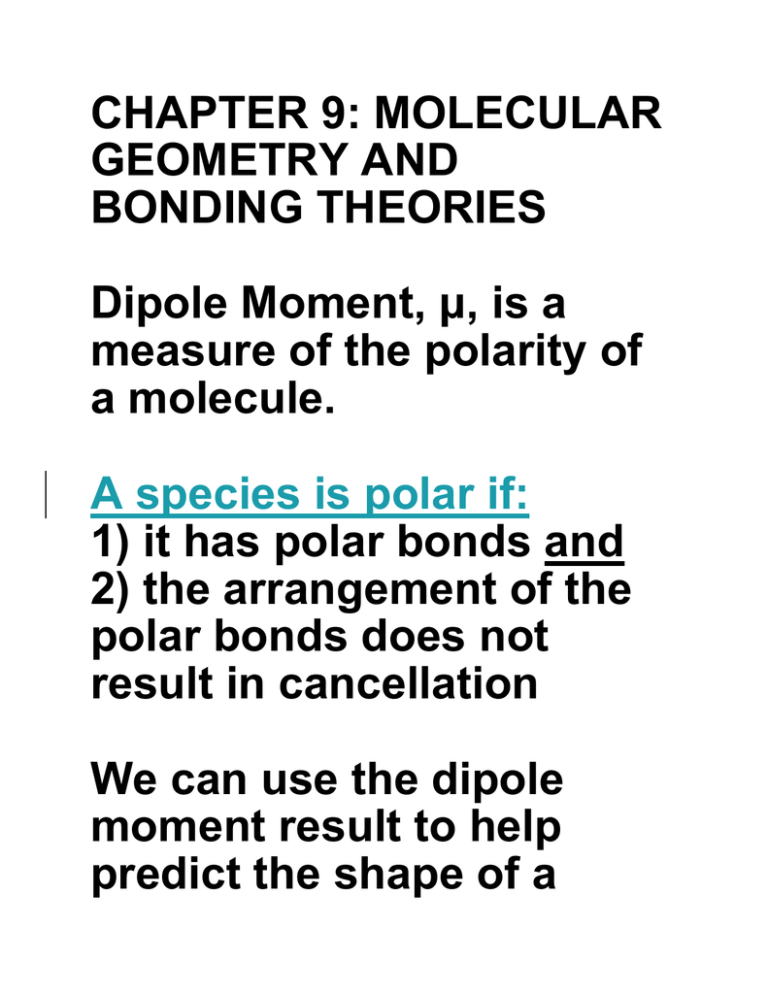CHAPTER 9: MOLECULAR GEOMETRY AND BONDING THEORIES
advertisement

CHAPTER 9: MOLECULAR GEOMETRY AND BONDING THEORIES Dipole Moment, μ, is a measure of the polarity of a molecule. A species is polar if: 1) it has polar bonds and 2) the arrangement of the polar bonds does not result in cancellation We can use the dipole moment result to help predict the shape of a molecule Predict the shape of CO2 ( μ=0), SO2 ( μ≠ 0) NH3 ( μ≠0), BCl3 ( μ=0) H2O( μ≠0) CH4( μ=0) Structures of Covalent species can also be predicted from their Lewis structures and Valence Shell Electron Pair Repulsion theory. VSEPR-the structure of a molecule is determined by placing the electron pairs (domains) around a central atom as far apart as possible. pairs of e (num. elec. pair of atoms) geometry 2 linear 3 trigonal planar 4 tetrahedral 5 trigonal bipyramidal 6 octahedral electron pair (domain) geometry - the arrangement around a central atom of all bond pairs and lone pairs of electrons. molecular geometry - the arrangement around a central atom of the bond pairs of electrons. (The true shape of a molecule) For central atoms without lone pairs: Elec. Pair Geom. = Mol. Geom. BeCl2, BCl3, CH4, PF5, SF6 For central atoms with lone pairs: Elec. Pair Geom ≠ Mol. Geom. NH3, H2O, SF4, XeF4 Predict the shape of molecules with double or triple bonds: CO2, C2H2, CH2O, O3 Tables 9.1, 2, 3, 4 summarize all info. on shape and hybridization. Valence Bond Theory- a bonding theory in which a covalent bond is formed by overlapping orbitals (atomic or hybrid) from two different atoms. Normally each atom contributes 1 efor a single bond, 2 for a double, and 3 for a triple bond. hybrid orbital - a bonding orbital made by mixing two or more atomic orbitals of the same atom. (sp, sp2, sp3, dsp3, d2sp3) pairs elec. pair of e geometry hybrid 2 linear sp 3 trigonal planar sp2 4 tetrahedral sp3 5 6 trigonal dsp3 bipyramidal octahedral d2sp3 Sigma bond- ( σ ) a bond formed by head to head overlap of orbitals in which the electron density is along the internuclear axis. Pi bond ( π) a bond formed by sideways overlap of "p" orbitals in which the electron density is above and below the internuclear axis. single bond is 1σ double bond is 1σ and 1π triple bond is 1σ and 2π Give the number of bonds (sigma and pi), hybridization and bond angle for the examples in 9.60 and 9.61 Bonding Theories: -VBT, Valence bonding theory, overlap of orbitals (atomic or hybrid on different atoms) -MOT, Molecular orbital theory, placing electrons into Molecular Orbitals, MO, made by combining atomic orbitals on different atoms. Electrons are added to follow Pauli Ex clusion Principle, PEP, and Hunds rule Bonding orbitals ale lower in E and Antibonding orbitals are higher in E. Bond Order =1/2 (# bonding e-#antibonding e) Diamagnetic- a substance with no unpaired electrons, repelled by a magnetic field Paramagnetic- a substance with unpaired electrons, attracted to a magnetic field.





